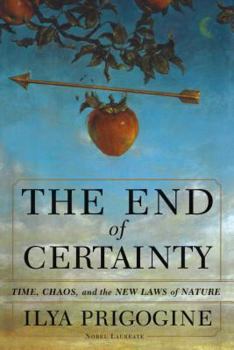The End of Certainty
Select Format
Select Condition 
Book Overview
The Nobel laureate and founder of chaos theory challenges the accepted laws of nature, explaining why Einstein's belief that time is merely an illusion is incorrect. This description may be from another edition of this product.
Format:Hardcover
Language:English
ISBN:0684837056
ISBN13:9780684837055
Release Date:August 1997
Publisher:Free Press
Length:240 Pages
Weight:0.94 lbs.
Dimensions:0.9" x 5.8" x 8.9"
Customer Reviews
4 ratings
A Crucial Piece of the Puzzle
Published by Thriftbooks.com User , 24 years ago
Many people presume that the integration of various domains of science into a single unified "superscience" will ultimately show that everything reduces to physics. In fact, one earlier reviewer of "The End of Certainty" closed his review saying, "Biology is, in the end, physics." There is a way in which biology could be "reduced" to physics, but only if we learn to define "physics" very differently than we do today. Prigogine shows why biology CANNOT be reduced to context-independent, deterministic contemporary physics. (Read Robert Rosen's "Essays on Life Itself" for the most profound and fundamental explanation, based on non-integrable, complex, "impredicative loops of efficient causation".)"The End of Certainty" is an important work because it points toward a revolutionary realignment of fundamental physical principles, theoretical perspectives, and even scientific methodology. In fact, it draws together many of the crucial elements that ultimately will result in the inevitable emergence of a fundamentally transformed model of scientific epistemology. It's an important snapshot of a pivotal stage in the evolution of scientific knowledge.There has not been a coherent major shift in the foundational paradigms of physical science since the emergence of relativity and quantum physics in the early 20th century. The pioneers of those physical models, if not the models themselves, behaved as feuding brothers from the start. That disputatious relationship is perhaps best typified by Einstein's famous rebuke of the indeterminacy of quantum physics: "God does not play dice with the universe." As usual, the enhanced perspective offered by an additional century of scientific enterprise shows us that neither side in the quantum dispute had an exclusive lock on the truth. If nothing else, Prigogine's work is a masterfully conceived reminder that we are fortunate to live in a time when a vastly larger shift in scientific world-view is imminent.This book's importance derives from its elegant (though highly technical) presentation of so many of the founding elements of what Erwin Schrödinger predicted would constitute a "new type of physical law". In fact, the controversy between Einstein's perspective and the views of quantum physicists like Schrödinger-a controversy that once commanded so much attention-has faded into an historical amusement. Instead, our advantage in standing on their shoulders is that, with the benefit of teachers like Ilya Prigogine, we can see beyond their semantic squabbles. It turns out that their views were congruent in at least one significant respect: both Einstein and Schrödinger knew that contemporary physics is inadequate to explain more complex phenomena...like biological life. That congruence is obvious in comparing Schrödinger's statement-"We must be prepared to find a new type of physical law prevailing in (the structure of living matter)."-with Einstein's equivalent assertion-"One can best feel in dealing with living things
Physically sound
Published by Thriftbooks.com User , 25 years ago
The writers do not challenge the validity of quantum mechanics. They point out, that microscopic reversability is compatible with the existence of an arrow of time in the observed world. This arrow of time exists, because time reversal of a macroscopic process, i.e. the same process going 'backwards' in time, is practically impossible, due e.g. to loss of information during quantum mechanical particle scattering. Bolzmann was critized in the 19th century for postulating a microscopic model which lacked time reversal symmetry; Prigogine and Sengers show, that macroscopic ensembles have an arrow of time even though the microscopic laws of quantum mechanics do not. Biology is, in the end, physics!
Science finds time, it's about time! Philosophically import.
Published by Thriftbooks.com User , 26 years ago
Oh well, I loved this book and think Prigogine's work is of fundamental importance. The math's not bad if you're from an engineering or science background, otherwise skip the math -- the text in the first 3 and ending chapters makes the point. One of the other reviewers got it all wrong. Just like we all seem to accept that there are no infinite velocities -- they do not exist -- so too, there is no infinitely precise location -- it does not exist either, independent of whether there's an observer or not. Without infinite precision, you get time, creativity and with a little intelligence, meaning (my claim, not Ilya's. Well at least science doesn't preclude it anymore...sort of a multi-century "D'oh!").Probability is now the fundamental unit of understanding and dynamics, not trajectories. What's neat is how well this dovetails into the Process Philosophers and theologians like Whitehead and Rav Abrahan Cook as well as Bhaskara way back in the 10th century.The section on cosmology is well in line with recent findings. I recommend the book.
Brilliant - probably solves 3 fundamental problems
Published by Thriftbooks.com User , 26 years ago
In a direct extension of his Nobel-prize-winning work on thermodynamics,Prigogine explains that almost all natural systems are non-determinsitic, even if all their components are subject to deterministic laws. This is because such systems have enormous numbers of Poincare resonances which lead to fundamentally non-deterministic solutions. This provides a solution to 3 of the most important problems in science: 1. Time's arrow 2. The Measurement Problem in QM 3. The existence of Freewill.Everyone who is seriously interested in these questions should read this book.





